The MyDigitalSSD SBX SSD Review: NVMe On The Cheap
by Billy Tallis on May 1, 2018 8:05 AM ESTSequential Read Performance
Our first test of sequential read performance uses short bursts of 128MB, issued as 128kB operations with no queuing. The test averages performance across eight bursts for a total of 1GB of data transferred from a drive containing 16GB of data. Between each burst the drive is given enough idle time to keep the overall duty cycle at 20%.

The burst sequential read speed of the MyDigitalSSD SBX is clearly faster than what SATA drives offer, but the Samsung drives and even the larger capacities of the Intel SSD 760p are in an entirely different league. The Phison E7 drives with planar MLC offer about the same performance as the SBX.
Our test of sustained sequential reads uses queue depths from 1 to 32, with the performance and power scores computed as the average of QD1, QD2 and QD4. Each queue depth is tested for up to one minute or 32GB transferred, from a drive containing 64GB of data.
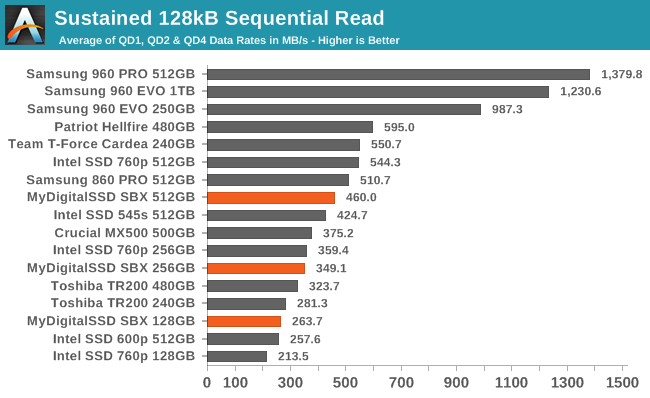
The flash is clearly much more of a bottleneck than the PCIe x2 interface on the longer sequential read test, where the internal fragmentation left over from the random write test prevents the SBX from delivering data any faster than the SATA SSDs. The Intel SSD 760p performs even worse at 128GB, but beats the SBX at 512GB.
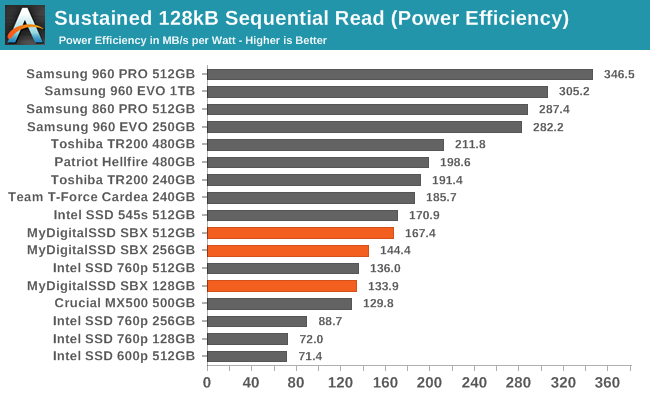 |
|||||||||
| Power Efficiency in MB/s/W | Average Power in W | ||||||||
Power efficiency continues to be a downside to the MyDigitalSSD SBX even though its power draw in absolute terms is substantially lower than the other NVMe drives. The Intel 760p is clearly worse off this time with much lower efficiency at every capacity, while Samsung's high-end drives are fast enough to offer efficiency as good or better than SATA drives.
 |
|||||||||
The sequential read performance of the SBX improves a bit between QD2 and QD8, allowing it to eventually surpass the Intel 760p that is generally better at QD1 but doesn't scale up with higher queue depths.
Sequential Write Performance
Our test of sequential write burst performance is structured identically to the sequential read burst performance test save for the direction of the data transfer. Each burst writes 128MB as 128kB operations issued at QD1, for a total of 1GB of data written to a drive containing 16GB of data.
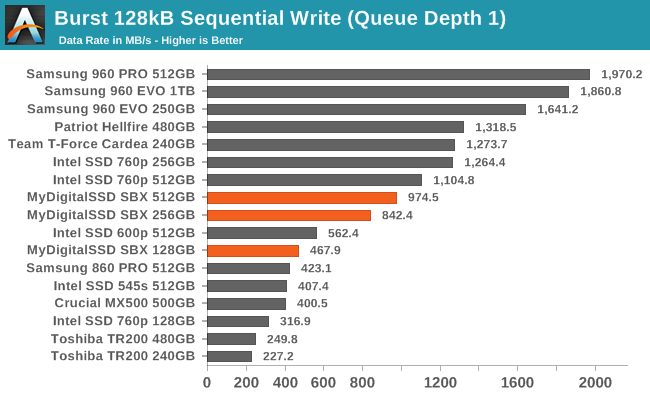
The burst sequential write speed of the MyDigitalSSD SBX exceeds that of SATA SSDs, though only barely in the case of the 128GB SBX. The 128GB Intel 760p fails to keep up with mainstream SATA drives, while the larger capacities have a clear lead over the SBX.
Our test of sustained sequential writes is structured identically to our sustained sequential read test, save for the direction of the data transfers. Queue depths range from 1 to 32 and each queue depth is tested for up to one minute or 32GB, followed by up to one minute of idle time for the drive to cool off and perform garbage collection. The test is confined to a 64GB span of the drive.
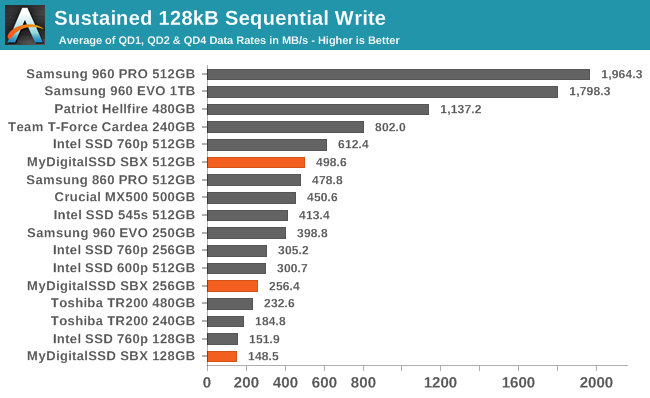
On the longer sequential write test, only the 512GB SBX is able to stay ahead of mainstream SATA SSDs. The Intel 760p has a minimal performance lead over the SBX at 128GB, growing to a 22% advantage at 512GB.
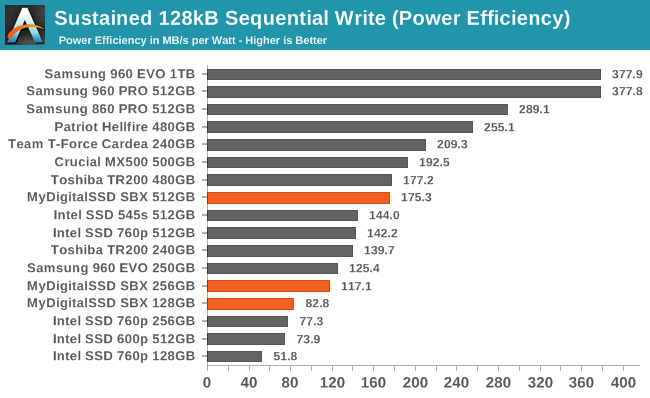 |
|||||||||
| Power Efficiency in MB/s/W | Average Power in W | ||||||||
The MyDitigalSSD SBX's power efficiency during sequential writes is better than Intel's drives, but not much else. The SBX is paying the power cost of PCIe (albeit only two lanes) but delivering SATA performance.
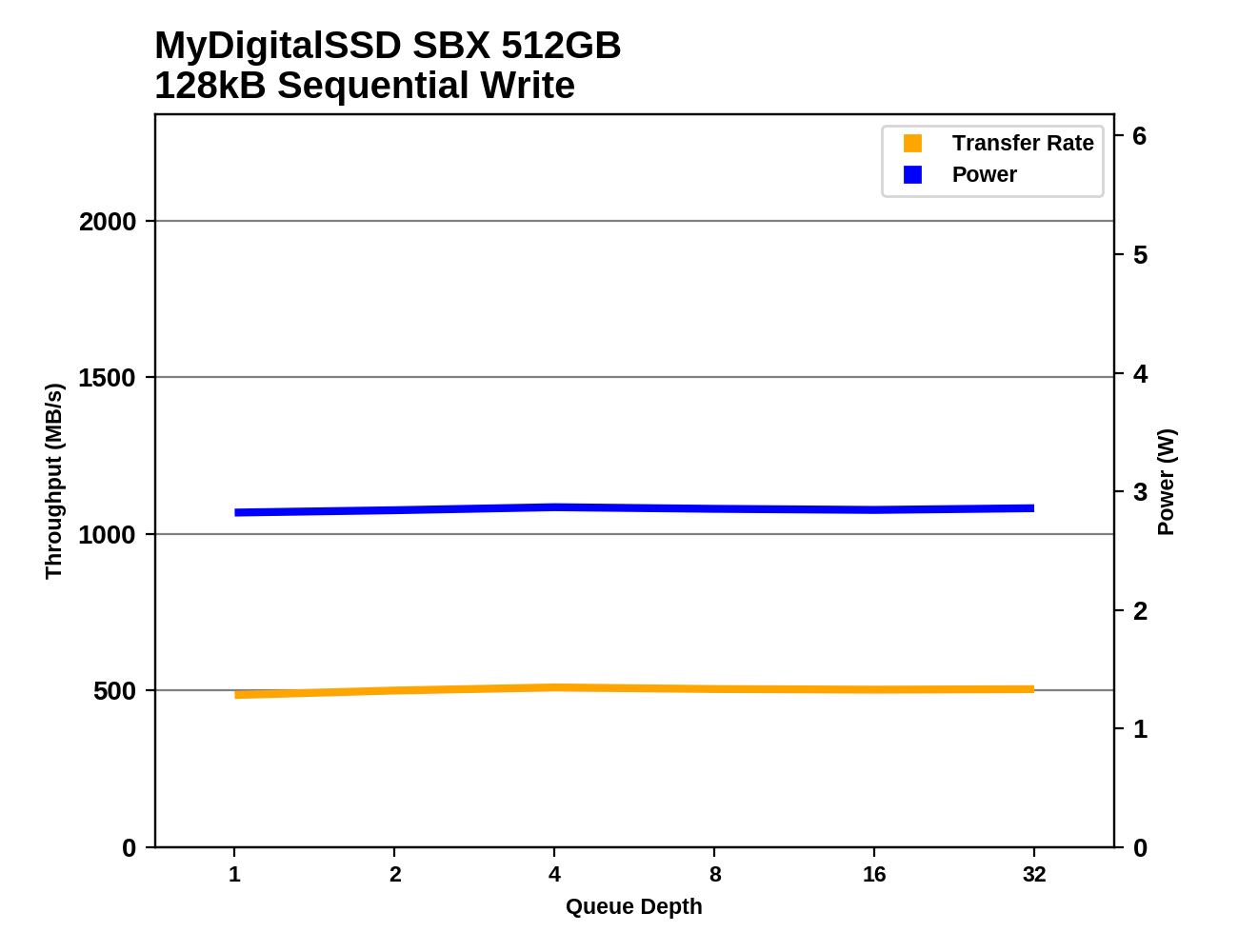 |
|||||||||
The MyDigitalSSD SBX delivers essentially the same sequential write performance at all tested queue depths, and power usage is also flat. The results from the SBX are most comparable to mainstream SATA drives, while the high-end NVMe drives are generally much faster and more power hungry.










46 Comments
View All Comments
MajGenRelativity - Tuesday, May 1, 2018 - link
The price premium of lower-end NVMe SSDs forms a big part of their problem in my head. When I build a computer for somebody, I usually use an M.2 SATA SSD if I include an SSD, because SATA SSDs are the cheaper alternative, and most people won't use the performance of an NVMe SSD. If they *do* need the performance of NVMe, I find it a little hard to justify stopping at the low end when they can pay a bit more and bump up the performance by quite a lot. My thoughts are that while products like the SBX are a step in the right direction, they really need to match SATA drives in price to become fully worthwhile.Dribble - Tuesday, May 1, 2018 - link
The other thing they have going for them is size. I can see a cheap nvme being used quite a bit in mid range laptops that came with a SATA disk but have a spare nvme slot. For desktops not only does the drive sit flush with the motherboard mostly, but it requires no cabling and no hd cage to put it in. I could see myself getting one as a second drive - it's not like I'd really be able to tell it's any slower then a high end drive for standard desktop usage.Dribble - Tuesday, May 1, 2018 - link
Ah didn't read the previous comment carefully enough "M2 SATA SSD" not "SATA SSD", never mind.MajGenRelativity - Tuesday, May 1, 2018 - link
Yeah. I can see 2.5" SATA going away entirely / being replaced by 2.5" U.2, but M.2 SATA still has a place for meeek2121 - Wednesday, May 2, 2018 - link
My current machine no longer has any type of SATA drive in it. I have a single 1TB Samsung 960 EVO. I thought about going going for the pro or a 2 TB EVO, but this fits my needs perfectly. Now if we could just get a mini-itx threadripper board... ;)MajGenRelativity - Thursday, May 3, 2018 - link
For me, I need bulk storage, so SATA isn't going away any time soon. However, I don't think Mini-ITX Threadripper will happen, as the socket is too bigRatman6161 - Monday, May 7, 2018 - link
Price wise, for a lot of people in your situation, you could get the 500 GB 960 EVO for $200 and also the 1 TB MX500 for $249. That would give you a total of 1.5 TB for the price of a 1 TB 960EVO. Then EVO could then be used for OS and programs with some data while the cheap but still pretty good MX500 could provide the big storage.gglaw - Saturday, May 19, 2018 - link
The popular budget Micron 3D TLC 2TB drives are on sale all the time from $280-$300 range. They don't have much marketing or even a fancy name associated with them, come in a bare OEM type box but the few reviews out are all favorable. I have one as a secondary storage drive with a 960 EVO 500GB boot drive but tbh when I moved my Steam library over to it, I can't even tell the difference in performance between it and the NVMe EVO.https://www.amazon.com/Micron-1100-SATA-2-5-inch-M...
that's the drive but it goes on sale lower than that pretty much every week.
wumpus - Tuesday, May 1, 2018 - link
Why eat the slot? Do your clients get grumpy if they see and "old fashioned" 2.5" drive? I'd rather leave the M.2 slot waiting for a card that really needs it, and still have the SATA drive connected.MajGenRelativity - Tuesday, May 1, 2018 - link
I sell to a variety of clients (I co-own a small business so we cover all sorts), and usually they don't have enough technical knowledge to know the difference between a 2.5" drive and M.2. I use the M.2 slot because it allows me to either disconnect the SATA cable (for a modular PSU), or tuck it out of the way to increase airflow. Most of my customers won't need the performance boost of upgrading to an NVMe drive, so it hasn't been a problem before. In the cases where that is a viable upgrade path, I discuss it ahead of time, and do use a 2.5" drive in situations where necessary/desired.